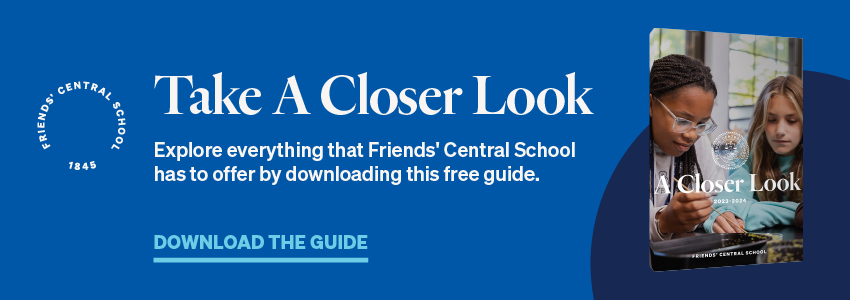 As parents and caregivers embrace a new school year and look for ways to ensure their young learners’ success and happiness, they may begin to explore the type of curriculum they’d like their child to focus on.
As parents and caregivers embrace a new school year and look for ways to ensure their young learners’ success and happiness, they may begin to explore the type of curriculum they’d like their child to focus on.
Most parents have no doubt already heard of STEM education (which stands for Science, Technology, Engineering, and Math) and understand its importance to their children’s future.
Free Downloadable Guide: Take a Closer Look at Friends' Central School
But while STEM remains a strong and prevalent focus for educators and caregivers alike, the growing focus on a new type of education—STEAM—is something parents must consider to ensure their children are as prepared and well-rounded as possible as they continue their educational journey.
Below we take a look at STEAM education, compare it to STEM, and walk through some of the key benefits that make it an excellent alternative for your child.
What is STEAM?
STEAM is an educational philosophy that evolved out of STEM, where the “A” stands for “Arts”: Science, Technology, Engineering, Art, and Math. A STEAM education, then, seeks to incorporate art alongside these other more technical subject areas.
What exactly counts as an “art” in the world of STEAM will vary from school to school. That being said, it typically involves language arts, visual arts, drama, and music to varying degrees.
STEAM vs. STEM
As the worlds of technology and industry exploded and began to drive nearly every element of our lives, STEM education was introduced to prepare young learners to take a productive role in innovative industries like healthcare, technology, and engineering. Giving students the skills needed to become real-life problem solvers and instilling a sense of excitement around learning are the core tenants of STEM, and the STEM focus opened new doors for countless young learners across the globe.
As the world continues to develop however, a new focus of education—STEAM—has been developed to go beyond just preparing children for the workforce, and brings the “elements of STEM together with arts to guide students’ critical thinking, inquiry, and dialogue.”
This type of learning acknowledges that individuals don’t just need expertise to be productive workers and members of society; they need creativity, collaboration, and critical thinking skills as well.
Fortunately for caregivers and educators alike, children are naturally inquisitive and eager to learn in this way, and as they learn and grow in a STEAM environment, the benefits are nearly infinite.
Benefits of a STEAM Education
1. Your child will gain exposure to new fields.
Like STEM, a STEAM education exposes young learners to a variety of fields and subjects and allows them to explore activities and areas they might not otherwise. This wide focus exposes them to fields and topics that may not naturally be available to them and allows them to explore each to determine where their interests and skills truly lie.
This exploration ensures that they can make a more informed and appropriate decision when it comes to choosing an area of focus or expertise as they continue to higher education.
2. Your child will learn important 21st century skills.
The core components of this way of learning, especially the focuses that STEAM offers, teaches students important 21st century skills. Allowing students to focus on deductive reasoning, problem solving and encouraging curiosity and persistence creates children who become naturally innovative, inventive, logical/critical thinkers and problem solvers. And the STEM portion of the curriculum gives young learners the technological literacy that is integral to success in the modern world.
Furthermore, young learners exposed to a STEAM curriculum develop the skills that are becoming increasingly important to today’s employers in order to prepare for a more successful career. These skills include:
- Technology Literacy: How to use technology
- Computational thinking: How do computers work
- Coding: How to write computer programs
- Robotics: How to actually build working robotics from physical components
- And more
3. They’ll also learn important soft skills.
With the introduction of the “A” in STEAM, students will experience an inclusion of the arts in their daily education. While this may not seem like an impactful addition, the arts help young learners develop “soft skills” like creativity, collaboration and problem-solving that make them more well-rounded and enthusiastic learners.
But what exactly are “soft skills” and why are they so important? The term ‘soft skills’ refers to those skills that are non-technical, but otherwise help ensure success and proficiency in both the personal and professional arenas. Soft skills can include:
- Interpersonal skills
- Communication ability
- Time management
- Empathy and listening
- Work ethic
- Creative thinking
- Conflict resolution
- Adaptability
These skills, while more difficult to measure and often more difficult to learn, ensure a child’s success both in their academic career and chances in the workforce. These skills partner with the technical and academic expertise instilled by a STEM education and ensure young learners are well-rounded and marketable on academic, personal, and professional levels.
4. Your child will be a better communicator.
It can be tempting to assume that STEM skills are the only skills that are required for your child’s success, and indeed, raising a young learner who is a whiz on the computer or excellent at math is important. However, this approach can result in intelligent children who otherwise lack the communication skills necessary to truly succeed later in life.
The inclusion of the arts that a STEAM education offers ensures that your young learner will not only be prepared academically but be an excellent communicator as well. The pairing of communication, collaboration, social and cultural skills involved in a STEAM curriculum ensures your child can express themselves verbally, visually, and socially. This improves their attitude towards learning, and results in empowered, successful learners.
5. Your child will develop their leadership skills.
While STEAM and STEM may seem like completely separate methods of learning, they are intrinsically linked. The art and soft skill focus of STEAM works to support the more technical aspect of STEM, and as such, children can apply the lessons and skills they learn into other areas of study and life, most notably, the ability to lead.
This form of learning provides students with the experiences necessary to become creative, adaptable leaders, and the confidence and ability of expression that comes from.
6. Your child will be more culturally competent.
In this current global climate, there may be nothing as important as ensuring we are raising a generation of individuals who are culturally competent citizens of the world. STEAM education ensures caregivers can do just that. STEAM curriculum exposes students to global cultures naturally through the introduction of different arts, music, drama and literature, and brings a diverse and colorful worldview to young learners each and every day.
Children with this background of learning become more competent, sensitive and aware members of their communities, and find themselves contributing to their communities in truly meaningful ways.
7. Your child will be more engaged.
Because STEAM education offers such a diverse and, often, customized curriculum that explores each student’s strengths, interests and passions, it ensures young learners feel engaged and empowered in their daily educational life.
And engaged students show a deeper level of commitment, responsibility and accountability to their education that sets them on track for success.
Raising a Well-Rounded Child
The benefits and advantages afforded by a STEAM curriculum cannot be overstated.
By exposing children to the technical and artistic aspects of education, while giving them the communication skills, empathy and appreciation for the world around them, parents, caregivers and educators ensure that young learners are well-rounded and prepared for the road ahead.



